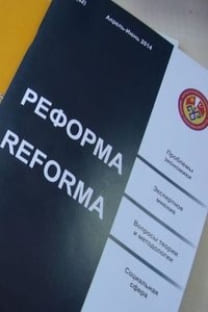THE ENDOGENOUS MONEY HYPOTHESIS: KYRGYZSTAN CASE
money endogeneity, monetary policy, National Bank of the Kyrgyz Republic
THE ENDOGENOUS MONEY HYPOTHESIS: KYRGYZSTAN CASE
___
- Bachurewicz G. R. (2019). “The Post-Keynesian endogenous-money supply: evidence from Poland”. Review of Keynesian Economics. 7:3, pp. 402-418. doi.org/10.4337/roke.2019.03.09
- Badarudin Z., Ariff M., Khalid A. (2009). “Money Supply Behaviour in Emerging Economies: a Comparative Analysis”. Journal of the Asia Pacific Economy. 14:4, pp. 331-350.
- Badarudin Z., Ariff M., Khalid A. (2013). “Post-Keynesian Money Endogeneity Evidence in G-7 Economies”. Journal of International Money and Finance. 33, pp. 146-162.
- Cepni O. & Guney I. E. (2017). “Endogeneity of Money Supply: Evidence from Turkey”. Journal of Finance & Banking Studies. 6:1, pp. 1-10. doi.org/10.20525/ijfbs.v6i1.680
- Fontana G. (2004). “Rethinking Endogenous Money: a Constructive Interpretation of the Debate between Accommodationists and Structuralists”. Metroeconomica. 55:4, pp. 367-385.
- Gavrovska M.M. & Slaveski T. (2019). “The Long-Run and Short-Run Endogeneity of Money Supply in the Republic of Macedonia: An Empirical Analysis”. International Conference on Eurasian Economies, pp. 71-83.
- Howells P.G.A. (1995). “The Demand for Endogenous Money”. Journal of Post Keynesian Economics. 18:1, pp. 89-106.
- Işik S. & Kahyaoğlu H. (2011). “The Endogenous Money Hypothesis: Some Evidence from Turkey”. Journal of Money, Investment and Banking. 19, pp. 61-71.
- Lopreite M. (2012). “The endogenous money hypothesis and securitization: the Euro area case (1999–2010)”. Economics Department Working Papers 2012-EP02. Department of Economics, Parma University (Italy). doi.org/10.2139/ssrn.2084197.
- Lopreite M. (2015). “Endogenous money and securitization. An analysis on United States (1999–2012)”. Journal of Applied Economic Sciences. X:1(31), pp. 142-151.
- McLeay M., Radia A., Thomas R. (2014). “Money Creation in the Modern Economy”. Bank of England Quarterly Bulletin. Q1, pp. 14-27.
- Moore B. (1989). “The Endogeneity of Credit Money”. Review of Political Economy. 1:1, pp. 64-93.
- Palley T. (1996). “Accommodationism Versus Structuralism: Time for an Accommodation”. Journal of Post Keynesian Economics. 18:4, pp. 585-594.
- Palley T. (1998). “Accommodationism, Structuralism and Superstructuralism.” Journal of Post Keynesian Economics. 21:1, pp. 171-173.
- Pollin R. (1991). “Two Theories of Money Supply Endogeneity: Some Empirical Evidence”. Journal of Post Keynesian Economics. 13:3, pp. 366-396.
- Shanmugam B., Nair M., Li O.W. (2003). “The endogenous money hypothesis: empirical evidence from Malaysia (1985-2000)”. Journal of Post Keynesian Economics. 25:4, pp. 599-611.
- Tas B. K. O. & Togay S. (2012). “A direct test of the endogeneity of money: Implications for Gulf Cooperation Council (GCC) countries”. Economic Modelling. 29:3, pp. 577-585. doi.org/10.1016/j.econmod.2011.12.015
- Vera A. (2001). “The Endogenous Money Hypothesis: Some Evidence from Spain (1987–1998)”. Journal of Post Keynesian Economics. 23, pp. 509-526.
- Vymyatnina Y. (2006). “How Much Control Does Bank of Russia Have Over Money Supply?”. Research in International Business and Finance. 20, pp. 131-144.
- Yurtkur A.K. (2019). “Para Arzının İçselliği Hipotezi: Türkiye İçin Ampirik Bir Analiz (2006-2018)”. UİİİD-IJEAS 24, ss. 131-150.
- Малкина М.Ю., Моисеев И.А. (2020). «Эндогенность предложения денег в российской экономике в условиях смены монетарного режима». Финансовый журнал. 12:3, с. 8-27. DOI: 10.31107/2075-1990-2020-3-8-27
- Трунин П.В., Ващелюк Н.В. (2015). «Анализ эндогенности предложения денег в России». Журнал Новой экономической ассоциации. 1:25, с. 103-131.
- ISSN: 1694-5158
- Yayın Aralığı: Yılda 2 Sayı
- Başlangıç: 1999
- Yayıncı: Kırgızistan Türkiye Manas Üniversitesi
THE MAIN PROBLEMS OF PENSION SYSTEM IN KYRGYZSTAN AND THEIR SOLUTION
Damira JAPAROVA, Aliya KANATOVA
KIRGIZİSTAN’DA SİGORTA SEKTÖRÜNÜN DURUMU VE GELİŞİMİ
THE IMPACT OF THE ELECTRIC POWER INDUSTRY ON THE ECONOMIC DEVELOPMENT OF KYRGYZSTAN
Nurzhan SHABIYEVA, Aidzhan SHABIEVA, Aktilek TOLUBAEV
CURRENT PROBLEMS OF THE ECONOMY
THE ROLE OF DIGITALIZATION IN THE DEVELOPMENT OF THE BORDER REGIONS IN KYRGYZSTAN
Kunduz AITMYRZAYEVA, Zhyldyz ADENOVA
THE ENDOGENOUS MONEY HYPOTHESIS: KYRGYZSTAN CASE
Junus GANIEV, Damira BAIGONUSHOVA
REPRODUCTION EFFICIENCY IN AGRICULTURE IN THE CONDITIONS OF EURASIAN INTEGRATION
Dzhumabek DZHAILOV, Kutpidin ERGESHOV
THE IMPACT OF PUBLIC EXTERNAL DEBT ON ECONOMIC GROWTH IN THE EURASIAN ECONOMIC UNION COUNTRIES
